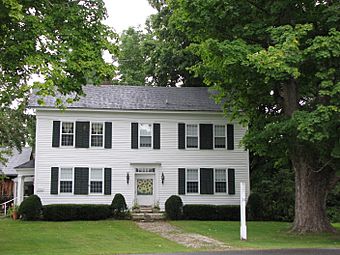Sheffield Plain Historic District facts for kids
Quick facts for kids |
|
|
Sheffield Plain Historic District
|
|

Noble house, south elevation, 2014 (1760 front to house with 1726 ell)
|
|
| Location | Sheffield, Massachusetts |
|---|---|
| Area | 27 acres (11 ha) |
| Architectural style | Greek Revival, Georgian, Federal |
| NRHP reference No. | 88000881 |
| Added to NRHP | June 23, 1988 |
The Sheffield Plain Historic District is a special area in Sheffield, Massachusetts. It includes the original village center from the 1700s. This long, narrow district stretches south for about 0.5 miles (0.80 km). It starts where United States Route 7 and Cook Road meet, which is also where the town's original common (a public park area) is located. This area mostly grew and developed in the mid-1700s and early 1800s. It was added to the National Register of Historic Places in 1988. This means it's recognized as an important historical site in the United States.
Contents
Discovering Sheffield Plain's History
The town of Sheffield is in the southwestern part of Massachusetts. It is just north of the border with Connecticut. The Plain district is a very rich and flat area of land. It lies on the west side of the Housatonic River, which flows through the town.
Early Settlers and First Buildings
Local Mahican people sold this land in 1724. The first settler, Matthew Noble, arrived around 1726. He built the very first house in what is now Sheffield. This house is still partly standing today. It forms an older section (called an "ell") of a larger house near Cook Street and US 7.
The area slowly grew over time. The main road running north-south (now US 7) was the busiest route. The town's first meeting house, a place for both church and town meetings, was likely built in 1735. It was located just west of the training ground. This training ground is now a triangular park. The home of Rev. Jonathan Hubbard, the first minister, was built in 1740. This house also still stands today as an older part of a house built in 1810 on US 7.
Growth and Change in Sheffield Plain
The area saw a second burst of growth after 1801. This was when a new turnpike (a toll road) was built. This road generally followed the path of US 7. Sheffield Plain became a busy town center. It had shops and taverns for travelers. The Sheffield Academy, a school, was built here in 1840. Its building was later moved to Sheffield Center.
However, things changed when a railroad was built. The train line followed the Housatonic River valley. The train station was located further south, away from Sheffield Plain. This meant the Plain lost its importance. The town's main activities, like government and church, moved to Sheffield Center. Because of this, not much new building has happened in the district since the late 1800s.
Architecture and Design of the District
The most important spot in the district is the triangular common. This park is located where Cook Road and US 7 meet. A line of buildings stretches south from this intersection. They are on both sides of US 7. This historic area meets newer buildings about 0.5 miles (0.80 km) to the south.
All the buildings in the district are made of wood. They are either 1-1/2 or 2-1/2 stories tall. Most are homes, or a mix of homes and shops. They show common styles from the past. These include Georgian, Federal, and Greek Revival designs. Some buildings also have small Victorian decorations added later.
Images for kids




